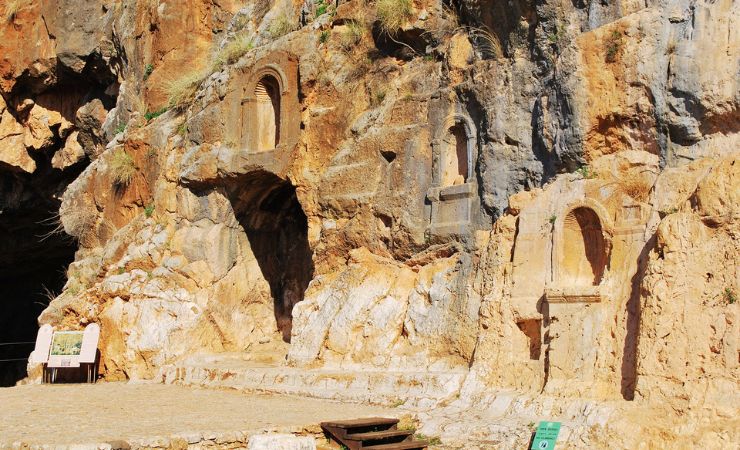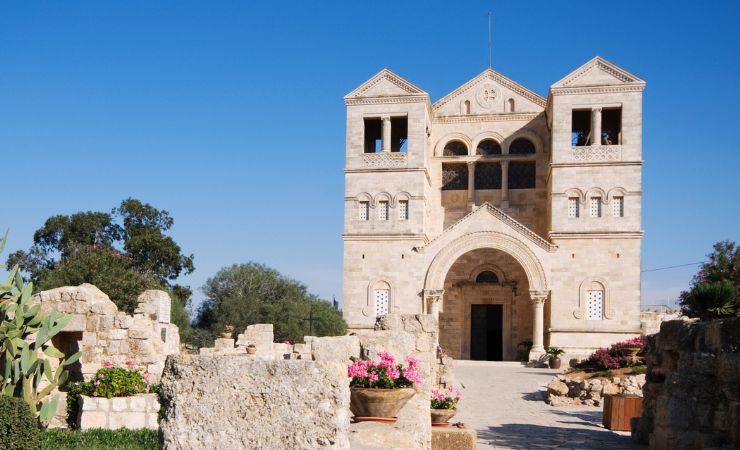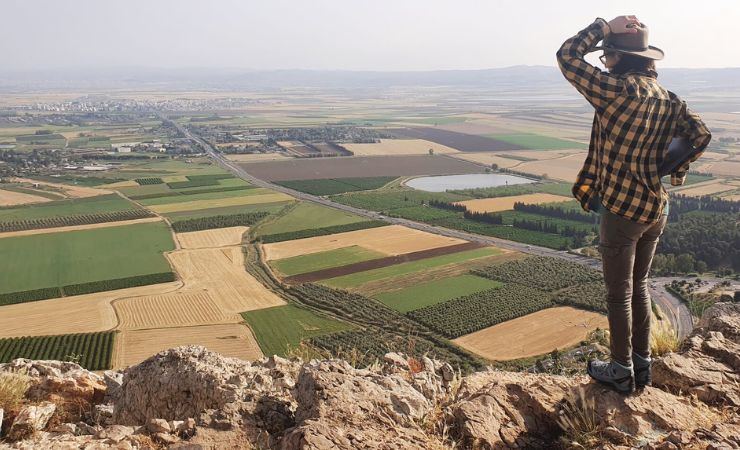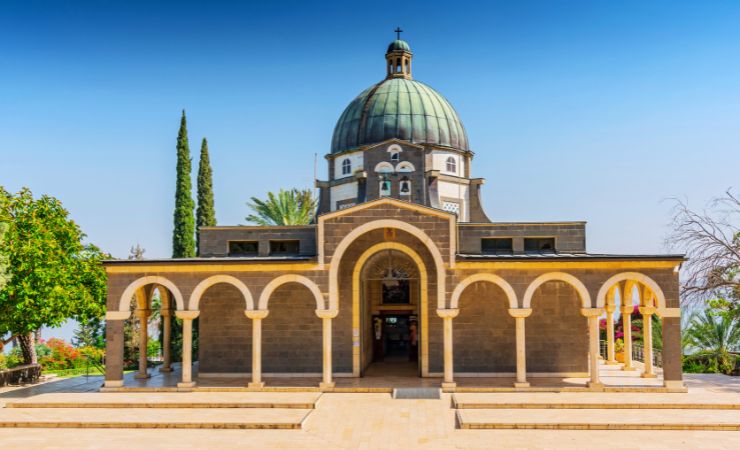Caesarea Philippi (Banias): Where the Gates of Hades and the Foundations of the Church Meet
Caesarea Philippi, historically known as Paneas or Banias, is an ancient site at the foot of Mount Hermon, near a major natural spring. Associated with the Greek god Pan, the city has over 2,000 years of layered history, from Hellenistic worship to modern archaeological discovery.
Location
Banias is located at the foot of Mount Hermon, north of the Golan Heights, in the area currently occupied by Israel. The site lies near a significant natural spring, which forms the Banias River (Nahal Hermon), one of the main tributaries of the Jordan River.
Biblical context
Caesarea Philippi is mentioned in the Gospels of Matthew and Mark as the location where Jesus confirmed Peter’s confession that he was the Messiah. According to Matthew 16:13–16, Jesus asked his disciples who people said he was. After hearing their answers, he asked who they themselves believed he was. Simon Peter replied, “You are the Christ, the Son of the living God.” Jesus responded by blessing Peter, noting that this revelation had come from God.
At the time of Christ, Caesarea Philippi featured six main sites dedicated to pagan worship:
A temple to Augustus Caesar
A courtyard for Pan worship
A temple dedicated to Zeus
The Court of Nemesis
The Upper Tomb Temple of the Dancing Goats
The Lower Tomb Temple of the Dancing Goats
The cave from which the spring emerged was believed to be the “Gate of the Underworld (Hades)”. Ancient sources describe disturbing rituals performed here, including the live sacrifice of children thrown into the cave and ritualistic acts involving goats and humans. Given the dark spiritual atmosphere, it is likely that Jesus’ disciples felt uneasy being brought to such a place.
Jesus deliberately chose this location to highlight the contrast between himself and the false gods worshiped there. In response to Peter’s confession, Jesus declared:
Following this event, Jesus began to prepare his disciples for his coming suffering, death, and resurrection in Jerusalem.



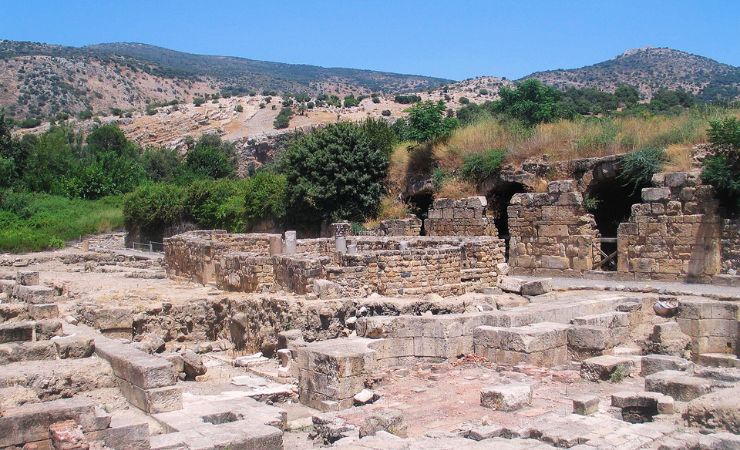
The History Caesarea Philippi
Hellenistic Period
The site was first settled during the Hellenistic period following the conquests of Alexander the Great. According to the historian Polybius, the Battle of Panium (c. 200–198 BCE) was fought here between the Seleucids and the Ptolemies.
In the 3rd century BCE, the Ptolemaic rulers established a cult center at the spring. After their defeat, the Seleucids built a pagan temple dedicated to Pan, the Greek god of nature and fertility.
Roman and Byzantine Periods
Upon the death of Zenodorus in 20 BC, Paneas and its surrounding region were annexed to the kingdom of Herod the Great. Herod constructed a white marble temple honoring Emperor Augustus, positioned directly in front of the cave from which the spring flowed. Later, Philip the Tetrarch, Herod’s son, founded and expanded a city at the site, naming it Caesarea or Caesarea Philippi after himself and the emperor.
Under King Agrippa II, the city was further expanded and temporarily renamed Neronias in honor of Emperor Nero.
Archaeological findings have identified remains of what is believed to be the palace of Philip and/or Agrippa II.
The sacred precinct (temenos) near the spring was constructed along a natural terrace on the cliff face. By the late 1st century CE, the area featured:
A temple built at the mouth of the cave
Ritual courtyards
Niches carved for statues
An open hospitality area in the style of a Roman triclinium-nymphaeum, possibly established by Agrippa II
During the 2nd–3rd centuries CE, additional temples and open cult areas dedicated to Pan and Zeus were built on the terrace.
The cave, continually full of water, remained a key element in the site’s worship practices.
Christian Period
In the 4th century CE, Paneas became a bishop’s seat, signaling the end of pagan worship of Pan. Two Christian churches were constructed:
A large basilica in the city’s center, built atop the ruins of the Roman columned building.
A smaller meeting building and chapel near the cave entrance, constructed over Roman foundations.
Early Muslim Period
After the Muslim conquest in the 7th century, Paneas became the capital of the al-Djawlan district. The once-prosperous, Hellenized city shrank significantly, with settlements concentrating near the spring and northwestern areas.
Archaeological evidence indicates that Jewish, Christian, and Muslim communities coexisted at the site at least until the end of the Umayyad period.
Excavations uncovered:
A synagogue from the 11th century CE, later converted into a mosque.
Gold coins and silver bracelets from the 10th century CE, suggesting a period of relative economic stability.
Crusader, Ayyubid, and Mamluk Periods
The Crusaders captured the city twice, calling it Belinas or Caesarea Philippi, and fortified it with a strong castle. After the Battle of Hattin in 1187, Saladin’s forces reclaimed Banias. The fortress was intentionally dismantled in the early 13th century to prevent its re-use by the Crusaders.
Later, al-‘Aziz ‘Uthman began rebuilding the Banias fortress in 1227.
The visible remains today — including large stone walls and fortified towers — date mainly from this 13th-century reconstruction.
Under the Mamluks, Banias became an important administrative center for the southern district of Damascus.
The Mamluk Sultan Baibars renovated the site again in 1265, reinforcing its strategic position and stationing military forces there.
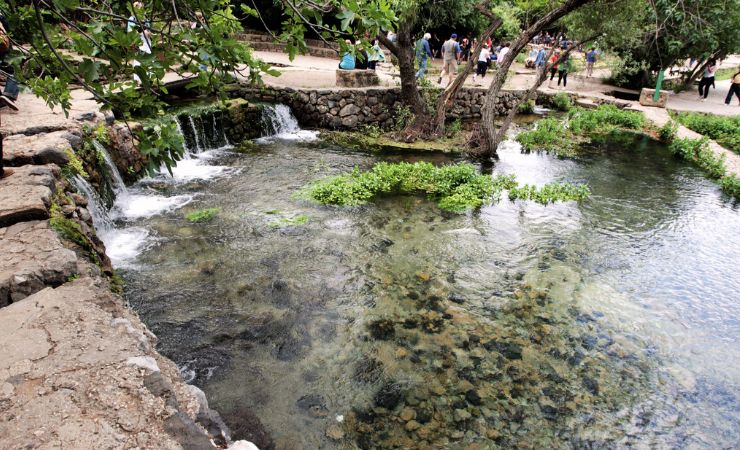
What Can be Seen at the Site Today
Today, Banias is part of the Hermon Stream (Banias) Nature Reserve, managed by the Israel Nature and Parks Authority.
The reserve is divided into two main areas: the archaeological site around the springs, and the Banias Waterfall area, accessible by a scenic hanging trail. The site is open to the public.
Visitors can see:
The Spring and Cave of Pan: The spring now seeps gently from the bedrock at the foot of the cliff. While it no longer gushes dramatically from the cave as it once did, the entrance to the Cave of Pan remains a striking feature.
Remnants of the Temple of Pan: Foundations and structural remains are visible, along with niches carved into the cliff face, where statues of deities were once placed.
Roman City Ruins: Portions of the Roman urban layout can still be explored, including sections associated with the palace of Agrippa II.
Remnants of Later Religious Structures: Parts of a church and a mosque, which survived after the destruction of village houses by Israeli bulldozers in 1967, are also present.
Mamluk Fortress (Burj): A well-preserved 13th-century gatehouse remains from the fortress rebuilt during the Mamluk period. It features a large room with an intact cross-vaulted ceiling.
Banias Waterfall and Hanging Trail: The famous Banias Waterfall can be reached by following a hanging trail along the Nahal Hermon (Banias River). Although entrance into the water is prohibited within the reserve, the trail offers close views of the rushing stream and lush surroundings.
Historic Industry Remains:
Along the paths, visitors can spot the ruins of abandoned flour mills powered by the stream and traces of the old TAP oil pipeline that once crossed the river.Natural Environment: The area around the spring and stream is rich with water vegetation, and the hillsides are covered with typical Mediterranean woodland plants.
Additional Information
Antiquity
- c. 200 BCE: The place is mentioned for the first time under the name Paneion or Paneas, suggesting its use for the worship of the god Pan.
- 19 BCE: Emperor Augustus grants the area around Paneas to King Herod. Herod builds a magnificent marble temple in honor of Augustus at the site, known as Paneion.
- 2 BCE: Following Herod’s death, his son Philip rules the area. He establishes his capital at Paneas and renames it Caesarea, later known as Caesarea Philippi to distinguish it from Caesarea Maritima.
- Mid-1st Century CE: Agrippa II rules the area and makes Caesarea Philippi his capital. Josephus writes that Agrippa II greatly embellished the city, building a large palace and temples adorned with statues.
- 1st Century CE (New Testament period): According to Christian tradition, Jesus is in the area of Caesarea Philippi with his disciples. Simon Peter declares Jesus to be the Messiah, and Jesus gives Peter the “keys to the kingdom of heaven.”
- Late 1st Century CE: The sacred area begins to be built, initially as an open hospitality complex in the Roman Triclinium-Nymphaeum style at the cave’s entrance, likely by Agrippa II.
- 2nd-3rd Centuries CE: Temples and open ritual complexes dedicated to Pan and Zeus are built on the terrace below the cliff, east of the cave.
- 4th Century CE: With the spread of Christianity, the city becomes a seat of a bishop in the Phoenician province. The pagan cult of Pan ceases, and the temples are abandoned. However, the city of Paneas continues to flourish, with new streets added. Agrippa II’s palace is converted into a bathhouse.
- Mid-5th Century CE: A decline in the city’s status is noted.
Early Muslim Period
- 7th Century CE: Following the Muslim conquest, Banias becomes the capital of the Golan district and is mentioned in several historical sources. The settlement area significantly shrinks, likely concentrating near the spring and the northwestern quarter.
- 10th Century CE: The Muslim geographer al-Muqaddasi mentions Banias as the granary of Damascus, suggesting its economy was quite healthy, supported by findings of gold coins and a pair of silver bracelets. The settlement, now called Banias, is renewed due to waves of Muslim immigration. Jews also arrive and form two communities: Jerusalemite and Babylonian.
- 11th Century CE (Mid): A document from the Cairo Genizah indicates an independent Beit Din (Jewish court) in Banias, suggesting a well-established and important community.
Middle Ages
- 1099: In response to the Crusader conquest of the Galilee, the Muslims fortify Banias.
- 1227: The ruler al-Aziz Uthman begins rebuilding the Banias fortress. Simultaneously, he builds the Qal’at al-Subayba fortress (Nimrod Fortress) above Banias as a military base.
- 1265: Mamluk Sultan Baybars renovates the city and stations a military unit there. Mamluk Banias is the administrative center of the southern district of Damascus and controls many villages in the Golan and Hula Valley.
Modern Period
- Early 19th Century CE: European travelers begin visiting and “discovering” the site. The first modern visitor is likely Seetzen, who in 1806 describes it as a village of about twenty miserable houses but notes the remains of the fortress, cave, and inscriptions on the cliff.
- Post-1948 Arab-Israeli War: This division is solidified, with only the southern part of the stream remaining under Israeli control. The Syrians take control of the northern part of the stream, which is defined as a demilitarized zone in the armistice agreement with Syria.
- 1977: The Banias Stream Nature Reserve is declared, and the archaeological site is included within it. Hiking trails are established within the reserve, allowing visitors to explore the ancient natural landscapes and archaeological remains from the Roman, Byzantine, and Crusader periods.
Nearby Sites
- Tel Dan Nature Reserve:
Important archaeological remains, including a Canaanite city gate and biblical-era structures. - Nimrod Fortress (Qal’at Namrud): A massive medieval fortress situated on the slopes of Mount Hermon.
- Hula Nature Reserve: A nature reserve, famous for its seasonal bird migrations, and wetland ecosystems.

